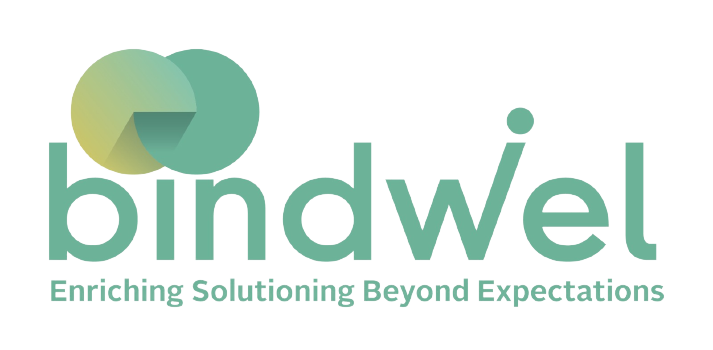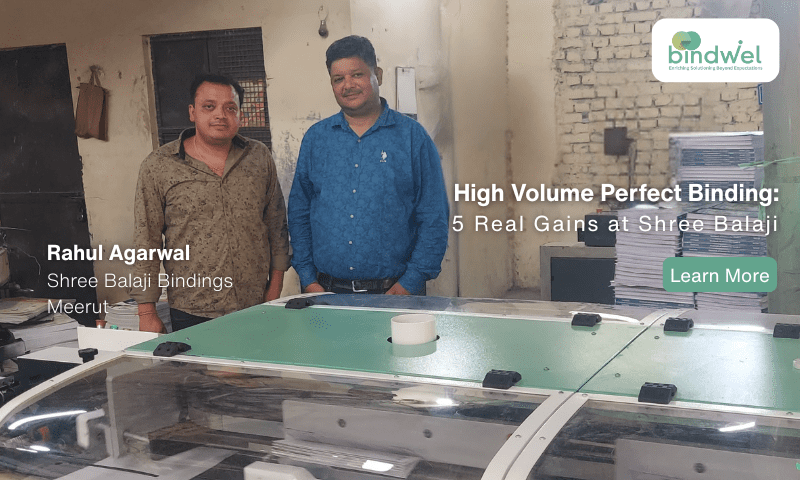(l-r) The nextgen Guptas- Rajiv, Sanjay, and Prashant
Seeking flexibility, SDR Printers opted for a Bindwel Freedom > 4K – 12-clamp perfect binder nine months ago. The book printing unit, based in Tronica city, in the outskirts of New Delhi, has been growing at a fair clip and so, new challenges required new solutions. A PrintWeek report.
Founded in 1998 by Anil Jain, the offset printing unit located in Nazafgarh Road focuses primarily on large Government tenders, across India, with a specific interest in textbooks.
SDR Printers produces educational books for leading MNC and Indian publishers. It provides end-to-end facility, beginning with pre-press to fulfilment. The company kept adding web offset machines to its array of Heidelberg sheetfeds, and did not realise that it was running out of space — space constraints for machines, some manual operations that took up space; and the work-in-progress between the sewing machine and the Welbound six-clamp binder.
The family-run company, established by LN Gupta in 1986, realised that it needed to have a long-term plan to service its customers better. And so, the new generation of Guptas — Sanjay, Deepak and Rajiv — got into action. They brainstormed and created a plan, which helped them increase the available space by acquiring a nearby factory and increasing internal efficiencies through replacement of machines.
The backbone of the print facility is an eight-colour heatset Heidelberg Harris reelfed machine. This is complete with an inline stacker that bundles the signatures into neat piles that can be transported for signature gathering.
Three high-speed folding machines support the four-colour sheetfed presses, three in all, from Heidelberg. Then there are five thread sewing machines which produce book blocks later bound by a six-clamp WB2000 plus an offline Kolbus binder.
As most of the books produced by SDR are either thread-sewn or wire-stitched before being covered on an adhesive binder, the speed differences among the machines posed a challenge to their production. So the first plan, along with increased space and installation of more sewing machines, was to boost the adhesive binding capability.


Books delivered into a conveyor connected to a trimmer
Multiple options
The SDR top management explored various options, including a pre-owned Kolbus line that would help streamline the workflow from gathering to three-knife trimming. “We had already seen a few machines in Europe and were in a discussion with Welbound Technical Services to inspect the line and then help commission the same in our factory,” Rajiv Gupta explains.
Anil Kumar, the Impel-Welbound head for sales, helped the Guptas and the shopfloor team through each and every step, even though the company was not considering an investment in a Welbound kit. Rajiv Gupta adds, “During PrintPack 2019, we learnt of the separation of the manufacturing arm from Kerala and the front-end headquartered in Mumbai, and that’s when we took a unanimous decision to invest in the Bindwel Freedom > 4K.”
Sanjay Gupta adds, “We evaluated the 12-clamp binder from Impel-Welbound during PrintPack 2019 and liked the concept. You can start with the binder, add a book block feeder when you need, add a gathering machine that can also have side stitching, and finally connect it to an inline trimmer. A solution that gave us complete freedom, of effectively utilising the resources — be it capital, space or manpower.”


Round-pile cover feeder allows additional stacking
Growth plans
Rajiv Gupta points out, “We had no doubt in our partner for our growth plans for bookbinding. Here was a person and his company which was willing to help us in any manner, even if it meant getting a pre-owned Kolbus commissioned. Welbound had a clear idea of the challenges faced by book printers. In fact, I think it probably has one of the best after-sales service teams for post-press in India. Plus, its own manufacturing plant in Karnataka. This backing, plus the benefits offered by the 12-clamp binder, made us pick the binder for our new capacity.”
Sanjay Gupta adds, “There were teething issues with the new machine in our place. We were moving from a six-clamp which is more forgiving in process issues. Also, we were moving to a system that had the capability to expand in both directions, and demanded that our process delivers inputs that are consistent.”
And so, the SDR top management invited Suresh Nair, the Impel-Welbound’s technical director, who is based in Bengaluru.
Rajiv Gupta says, “Nair visited us and spent two days in educating us and our operations team about the ‘do’s and don’ts’ and also highlighted a few gaps in process and equipment. The Impel-Welbound team even spent time in adjusting other machines like the thread-sewing machines, so that the binder received consistent inputs.”
The right solution
SDR believes that it invested in the right solution that can be expanded with gluing options and add-ons before or after the binder. The Bindwel Freedom > 4K binder is capable of producing 4,000 books per hour, has centrally-adjustable twelve book clamps, an infeed and a lay-down delivery that takes the books to an inline trimmer.
Impel-Welbound is selling bindery in the Indian and African markets. Some of these are shipped as gathering-binding combination with an in-line Signa gatherer. And a few have opted for PUR gluing in addition to EVA. According to Kumar of Impel-Welbound, the book printers in North India are demanding more throughputs. So far, pre-owned, European equipment have not delivered as per expectations. Most of them operate at half the rated speed and create maintenance issues. Therefore, a new machine that can have modular add-ons is the right tech-option.
Key SDR customers are Orient Blackswan (OBS), McGraw Hill and Rachna Sagar. The Guptas are very proud about the fact that they bagged the first prize in excellence in book production from the Federation of Indian Publishers. This was the Sangam Atlas produced for OBS.
Five simple tips from Suresh Nair, the Impel-Welbound CTO
- 1. Inline binders help you reduce the space requirement by 50% and man-power requirements by 70%.
- 2. Pre-owned binders run at very low operational efficiencies – be it speed, turnaround times or break-downs – turn out expensive even in the medium-run.
- 3. Per book cost is absolutely important, whether you are servicing an MNC publisher or a government textbook board. It is not the investment cost that matters.
- 4. Inline binders are less forgiving than the offline solutions when it comes to quality and consistency of the inputs. Be it the quality of pressed and stacked signatures, book block thickness uniformity, consistency and tightness of thread-sewing or conformity of side stitching.
- But then all these are important for reducing in-process wastage as well as delivering quality output at increased speeds. So if you are waiting for the day when all these inputs improve before you invest in an inline binding solution, then it will be too late. Buy the horse and the process of fitting the cart will automatically follow.
- 5. It is high time to look at the long term objectives to save costs; be it choosing the right grain direction, making the cover longer than the book block, having regular maintenance plan for your old machines, moving to non-pigmented better quality adhesives, using a high capacity melter while doing thick books, have energy audits done and most importantly, safety first.





